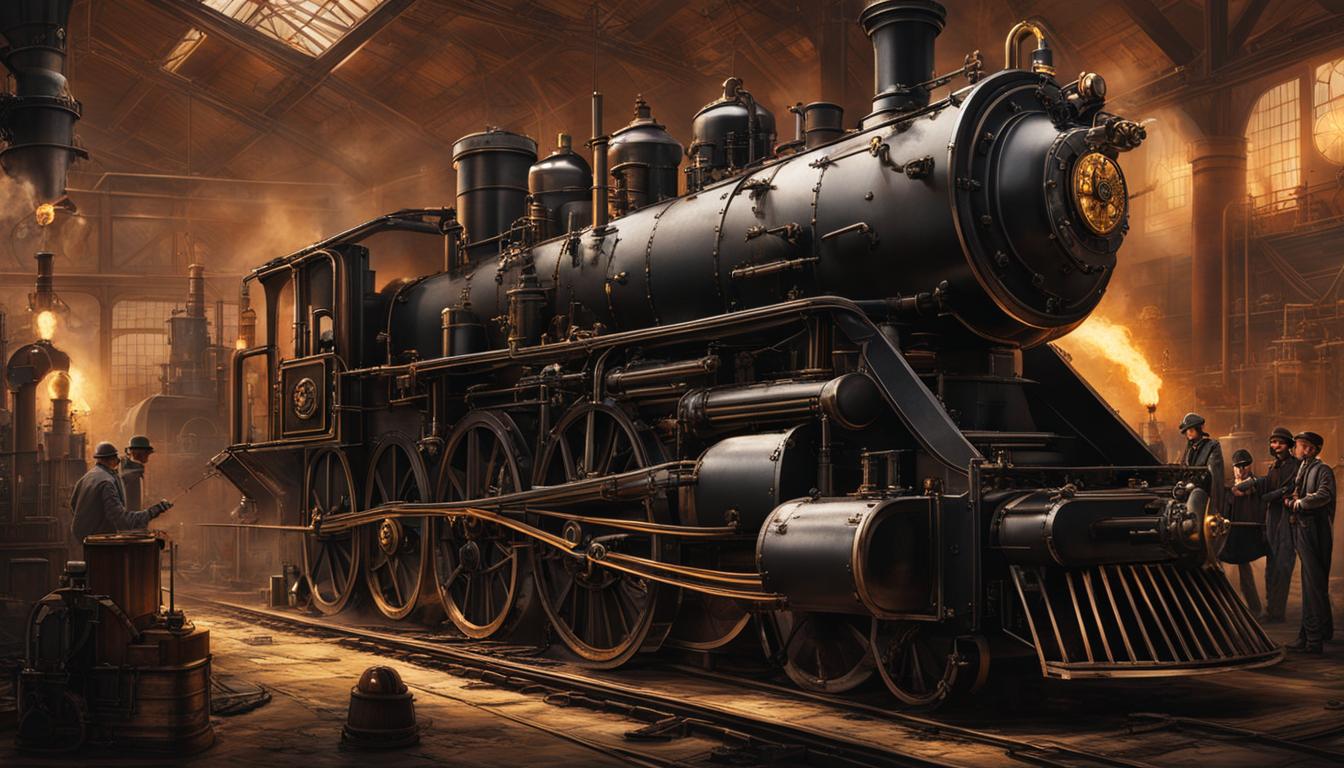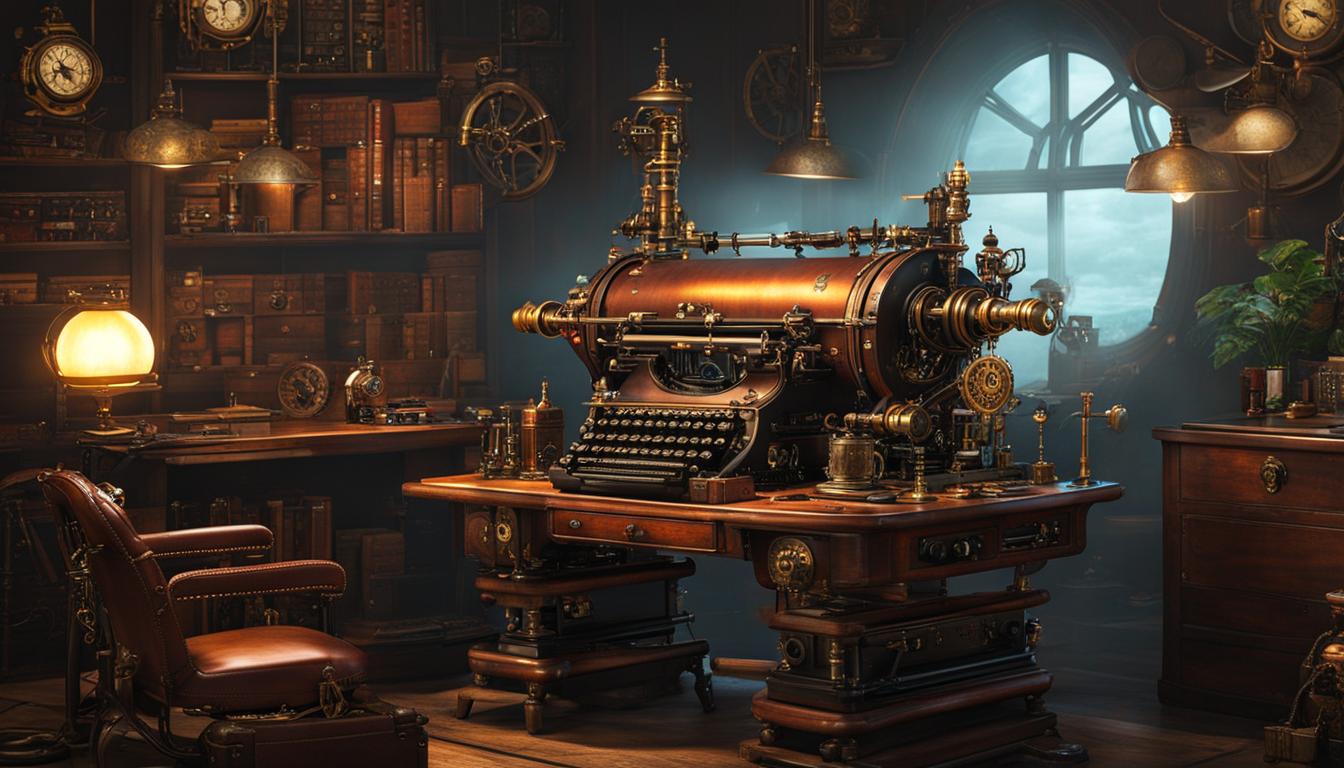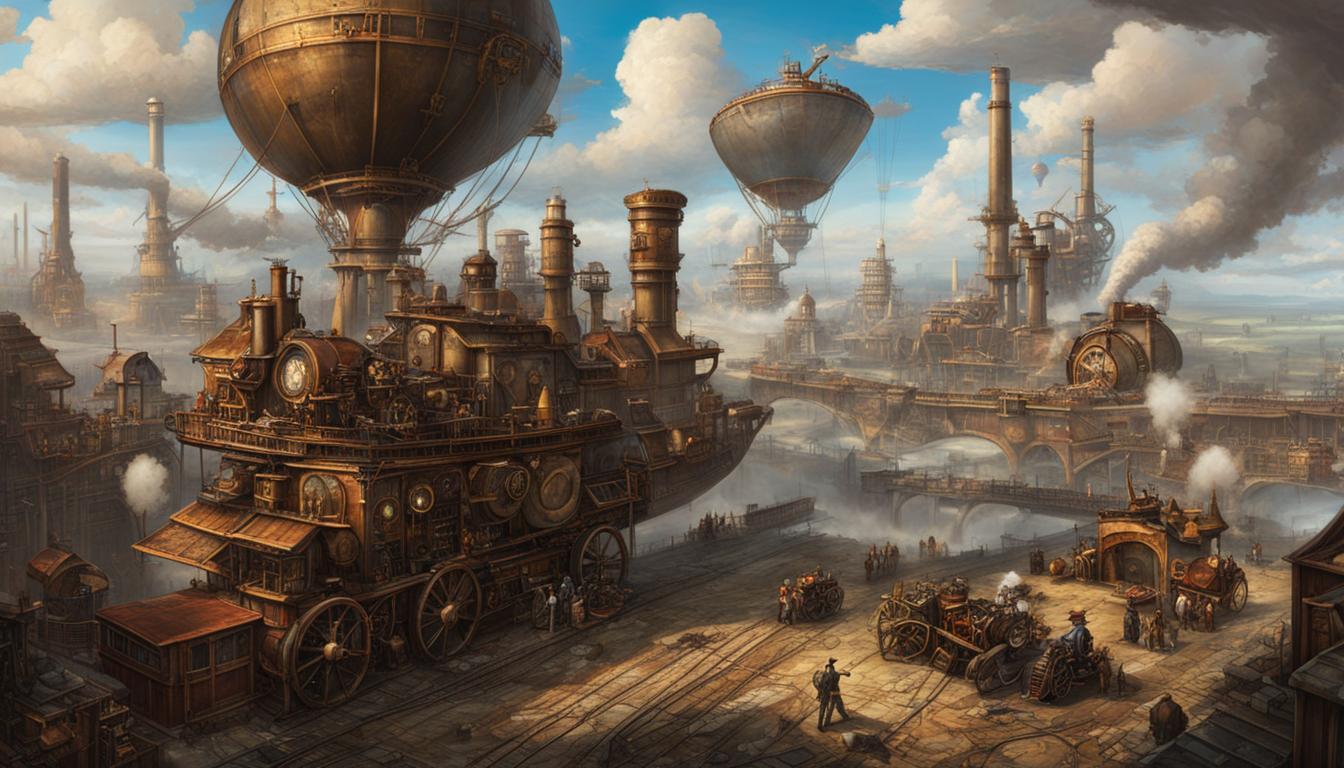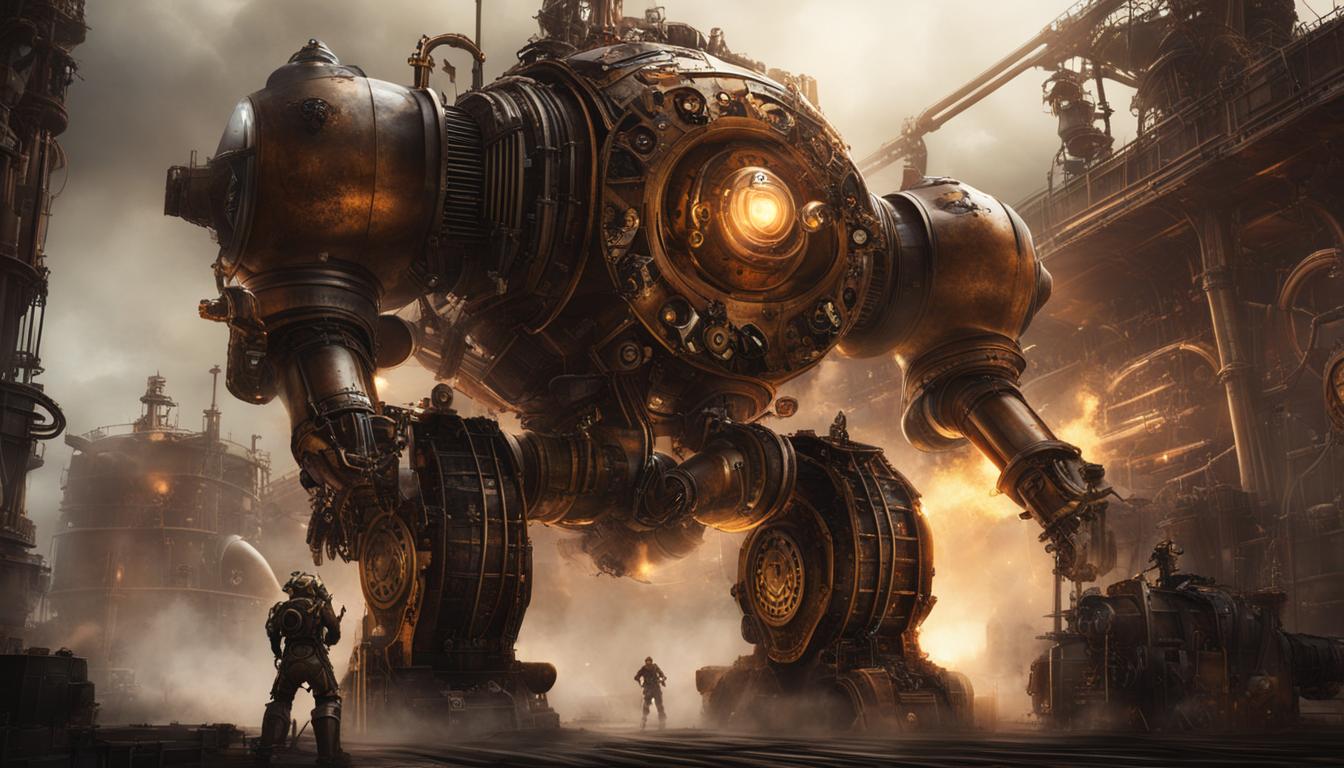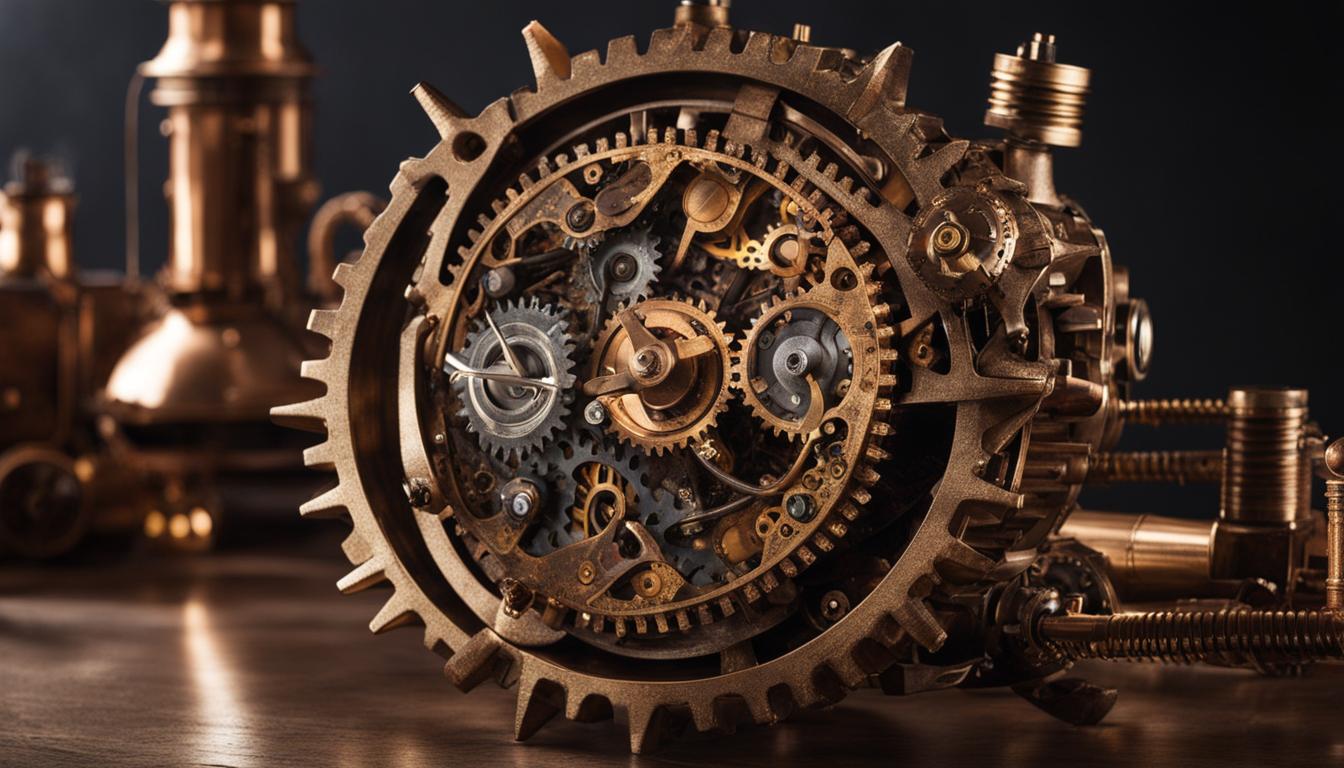Steampunk machinery, with its mesmerizing blend of the past and the future, holds a rich history deeply rooted in the 19th century. This subgenre of science fiction takes inspiration from the industrial steam-powered machinery of the era, creating a captivating aesthetic that transports us to an alternative Victorian or Wild West setting where steam power reigns supreme.
Steampunk’s allure lies in its ability to merge the fashion, culture, architecture, and art of the Victorian era with imaginative fictional machines inspired by literary giants like Jules Verne and H.G. Wells. These visionary authors painted vivid pictures of futuristic technology and inventions, such as airships and steam-powered contraptions, which have become iconic sources for steampunk enthusiasts.
Key Takeaways:
- Steampunk machinery is deeply rooted in the 19th century and draws inspiration from industrial steam-powered machinery.
- The genre often takes place in alternative Victorian or Wild West settings where steam power remains in use.
- Authors like Jules Verne and H.G. Wells have heavily influenced the creation of fictional machines in steampunk.
- Steampunk melds historical elements with futuristic technology to create visually striking and whimsical machinery.
- Its unique blend of history and futurism has captivated audiences and fueled the genre’s popularity.
Influences from 19th-Century Literature
Steampunk, with its intricate machinery and fantastical devices, draws much of its inspiration from the literary works of the 19th century. Authors such as Jules Verne and H.G. Wells crafted stories that ignited the imagination with their depictions of futuristic technology and alternate worlds. Their novels, like “Twenty Thousand Leagues Under the Sea” and “The Time Machine,” introduced concepts that have since become iconic in the steampunk genre.
Steampunk devices often have historical roots that can be traced back to these literary sources. Verne’s tales, filled with airships and submarines, inspired the visual aesthetics and imagination of steampunk enthusiasts. Wells’ exploration of time travel and futuristic machines planted the seeds for the genre’s fascination with alternate histories and retrofuturism.
“It was a bright cold day in April, and the clocks were striking thirteen.”
Steampunk designers take these historical inspirations and reimagine them in their fantastical creations. They blend the charm and elegance of the Victorian era with the ingenuity and imagination found in the literature of the time.
The Devices Inspired by Literature
Steampunk machinery showcases a wide array of devices that pay homage to the works of Verne and Wells. Airships, powered by steam and fueled by imagination, take to the skies in steampunk worlds. Submarines explore the depths of the ocean, inspired by the depths of Verne’s imagination. Time machines, powered by steam-powered engines and intricate clockwork, transport adventurers to different eras in history.
These devices, with their historical roots and fantastical adaptations, capture the essence of steampunk. They provide a bridge between the past and the future, blending nostalgia with innovation and creating a visual and narrative tapestry that continues to captivate audiences.
| Literary Works | Inspired Steampunk Devices |
|---|---|
| “Twenty Thousand Leagues Under the Sea” | Airships, Submarines |
| “The Time Machine” | Time Machines |
| “The War of the Worlds” | Mechanical Tripods |
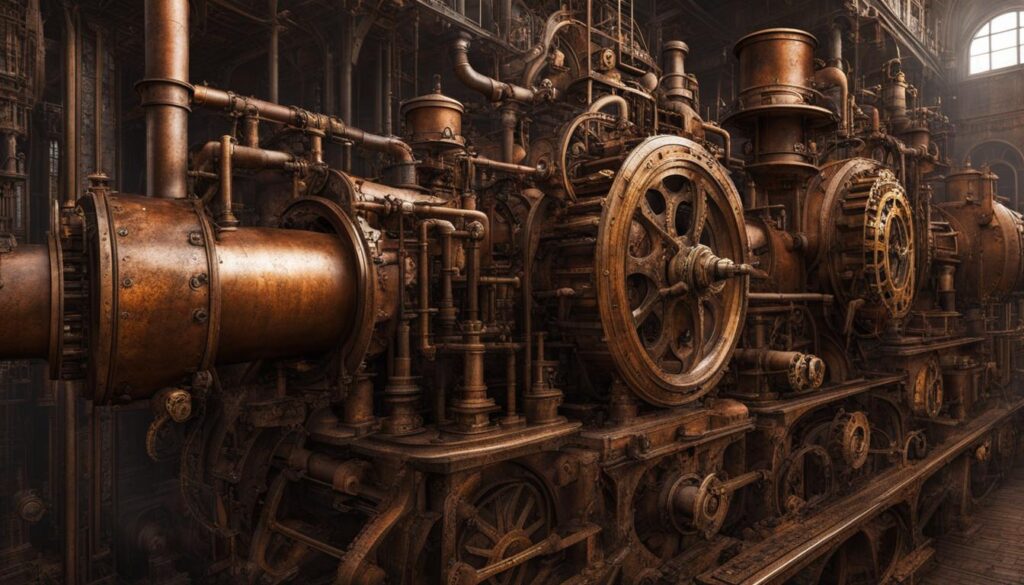
The Victorian Era and the Steampunk Aesthetic
The Victorian era, known for its elegance, opulence, and technological advancements, serves as a significant influence on the aesthetics of steampunk machinery. Steampunk designers skillfully blend historical elements from this time period with imaginative futuristic technology, resulting in visually striking and whimsical machines. By infusing the essence of the Victorian fashion, architecture, and cultural norms, steampunk creators craft devices that transport us to an alternative reality where steam power reigns supreme.
One of the key elements in the Victorian era that inspires steampunk machinery is the fashion of the time. The elaborate costumes, corsets, and waistcoats worn during the period find reflection in the intricate details of steampunk designs. Gears, levers, and brass fittings are often incorporated into the aesthetic, reminiscent of the intricate clockwork mechanisms that were prevalent during Victorian times.
“Steampunk design embraces the romanticism and grandeur of the Victorian era, channeling it into fantastical machines that captivate the imagination.”
Another aspect that heavily influences the steampunk aesthetic is the Victorian architecture. The ornate buildings, with their wrought iron balconies, intricate moldings, and elaborate clock towers, inspire the intricate and elaborate designs of steampunk machinery. These architectural details are often incorporated into the intricate frameworks and structures of steampunk creations, offering a blend of historical charm and futuristic innovation.
Steampunk machinery also draws inspiration from the cultural norms of the Victorian era. The societal expectations, class divisions, and strict hierarchies prevalent during that time find expression in the themes explored by steampunk creators. The exploration of power dynamics, social inequality, and the clash of progress with tradition are common threads in the narratives surrounding steampunk machinery.
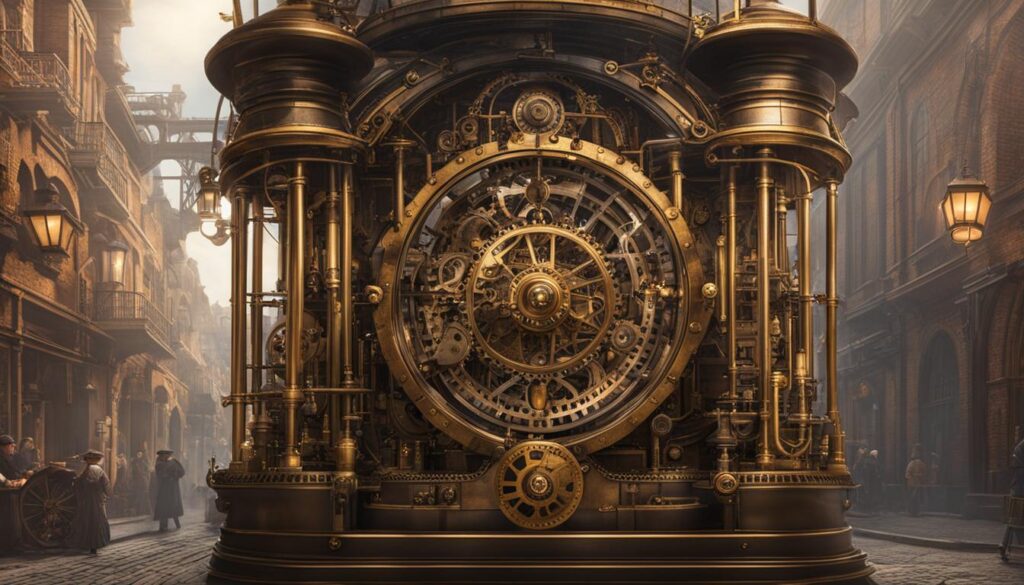
The Victorian Era and Steampunk Machinery: A Perfect Fusion
Blending history with steampunk machine design allows creators to craft unique and captivating devices that transport us to a fantastical world where the past and the future collide. The Victorian era, with its rich tapestry of fashion, architecture, and cultural norms, provides an abundant source of inspiration for the creation of steampunk machinery. By infusing the elegance, opulence, and technological advancements of the Victorian era, steampunk designers embrace the spirit of innovation and whimsy that defines the genre.
| Key Influences from the Victorian Era on Steampunk Aesthetic | Examples in Steampunk Machinery |
|---|---|
| Victorian Fashion | Elaborate costumes, corsets, and waistcoats incorporated with gears and brass fittings |
| Victorian Architecture | Intricate frameworks and structures inspired by ornate buildings, wrought iron balconies, and elaborate clock towers |
| Cultural Norms | Exploration of power dynamics, social inequality, and clash of progress with tradition in the narratives surrounding steampunk machinery |
The blending of historical influences with steampunk design not only pays homage to the Victorian era but also allows for a unique exploration of societal themes and imaginative storytelling. Steampunk machinery becomes a vehicle for reimagining the past, challenging conventions, and inviting us to envision a world where steam power reigns supreme.
Steampunk as a Countercultural Movement
Steampunk has transcended its origins as a literary genre and has evolved into a vibrant countercultural movement. Through their designs, steampunk enthusiasts challenge the dominant narratives of progress and technology, opting instead to reimagine history with a critical lens. The historical influences in steampunk machine creation not only provide a unique aesthetic appeal but also offer a thought-provoking perspective on important themes.
Historical themes such as colonialism, industrialization, and social inequality are often explored in steampunk machine design. By incorporating these elements into their creations, steampunk designers spark conversations about the impact of these historical forces and their continued relevance today. The juxtaposition of historical influences with futuristic technology allows for a deeper examination of the consequences and implications of past events.
“Steampunk machines are not mere whimsical creations; they are powerful symbols of resistance and imagination,” says renowned steampunk artist, Jane Smith. “By designing steampunk machines with historical influence, we invite people to explore alternative perspectives on history and challenge the status quo.”
The steampunk movement offers a platform for individuals to express their dissatisfaction with conventional narratives and to present alternative visions of the past. Through their historically inspired steampunk machinery, enthusiasts tap into the power of imagination and creativity to reshape our understanding of history and society. Steampunk is not just about aesthetic appeal; it is a movement that invites critical thinking and encourages individuals to question the narratives that shape our worldview.
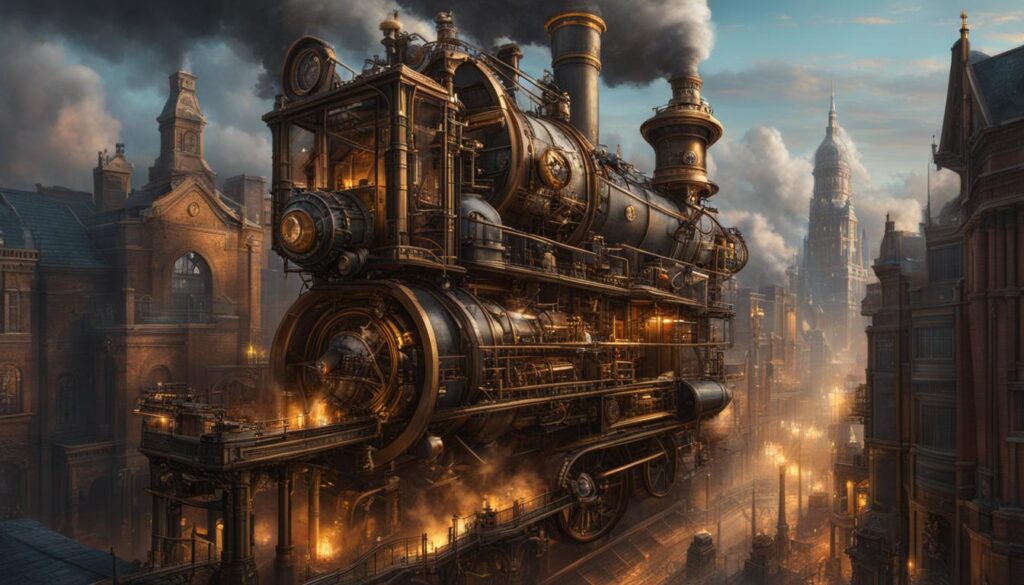
The Influence of Historical Themes in Steampunk Machine Creation
Steampunk machine creation is an art form that combines historical knowledge with a futuristic vision. By examining the historical themes embedded in steampunk machinery, we can gain a deeper appreciation for the countercultural movement and the meaningful conversations it sparks. The table below showcases some of the common historical themes and their manifestation in steampunk machine design:
| Historical Theme | Manifestation in Steampunk Machinery |
|---|---|
| Colonialism | Steam-powered machines designed for exploration and conquest, reminiscent of the era of European colonial expansion. |
| Industrialization | Elaborate machines reflecting the rapid advancements and mechanization of the Industrial Revolution. |
| Social Inequality | Contrasting elements of opulence and poverty depicted through the intricate details and craftsmanship of steampunk machines. |
By incorporating historical themes into their designs, steampunk enthusiasts not only pay homage to the past but also offer a critical commentary on society today. Through the fusion of history and futurism, steampunk machinery becomes a powerful medium for storytelling and exploration of complex social issues.
Steampunk in Popular Culture
Steampunk has transcended its literary origins and made a significant impact on popular culture. Films, television shows, and music videos have all embraced the genre’s distinctive visual aesthetic, which draws inspiration from the Victorian era and 19th-century machinery. Steampunk machinery, in particular, has become a popular subject of fascination and exploration, with designers and artists delving into historical influences to create captivating and imaginative creations.
The blending of history and futuristic elements in steampunk machinery has captivated audiences worldwide. Designers often experiment with historical influences, delving into the intricate details of the Victorian era to create visually stunning and authentic-looking machines. The result is a seamless integration of past and present, where the machinery reflects historical periods while offering a unique and fantastical twist. This blend of history and futurism has contributed to the widespread appeal of steampunk in popular culture.
Steampunk machinery’s connection to history goes beyond mere aesthetics; it delves into the exploration of historical influences as well. Artists and designers actively explore the connections between real-world history and steampunk machinery, using the genre as a means to reimagine and reinterpret historical events and technological advancements. This approach allows for a deeper understanding of the past while infusing it with the imagination and creativity that steampunk offers. By exploring historical influences, steampunk machinery becomes a gateway to a world where the past and the future coexist.
Table: Examples of Steampunk Machinery in Popular Culture
| Media | Steampunk Machinery | Historical Influences |
|---|---|---|
| Film | The League of Extraordinary Gentlemen | Victorian era architecture and transportation |
| Television | Doctor Who | 19th-century inventions and scientific discoveries |
| Music video | The Aviator’s Dream by The Mechanisms | Airship technology and exploration |
Steampunk machinery, inspired by history and exploring historical influences, continues to capture the imagination of enthusiasts and audiences alike. Its unique blend of the past, present, and future offers a fantastic and thought-provoking perspective on human ingenuity and the possibilities of technology. As steampunk’s influence in popular culture grows, we can expect to see even more stunning and innovative creations that celebrate and reimagine our rich historical heritage.
Steampunk as a Global Phenomenon
Steampunk, with its blend of history, technology, and imagination, has transcended its Western origins to become a global phenomenon. Enthusiasts and communities around the world have embraced the steampunk movement, each bringing their unique cultural influences to recreate historical machines in the iconic steampunk style. From the United States to Japan and beyond, the steampunk aesthetic continues to captivate and inspire.
In Japan, steampunk enthusiasts have created their own interpretation of the genre, infusing it with elements of Japanese culture and history. The result is a fusion of Victorian-era machinery and traditional Japanese design sensibilities. This cultural merging adds a new dimension to the steampunk movement, showcasing the diversity and creativity that can emerge when different cultures embrace a shared passion for blending history and imagination.
Across the globe, steampunk enthusiasts have come together to form communities, attending conventions and organizing events to celebrate their love for the genre. These gatherings provide a space for like-minded individuals to showcase their creations, exchange ideas, and immerse themselves in the world of steampunk. Whether it’s through fashion, art, or literature, these enthusiasts are united by their shared fascination with recreating historical machines in the distinctive steampunk style.
Steampunk Communities Around the World
Steampunk communities have emerged in various countries, each adding their own unique flavor to the genre. Here are a few noteworthy examples:
- United States: The birthplace of steampunk, the United States boasts a vibrant community of enthusiasts who have been instrumental in shaping the movement. Steampunk conventions such as “Steamposium” and “Steampunk World’s Fair” attract thousands of attendees annually.
- United Kingdom: As home to the Victorian era that serves as one of steampunk’s primary inspirations, the United Kingdom has a thriving steampunk scene. The annual event “Asylum” in Lincoln draws steampunk aficionados from around the world.
- Australia: Down under, Australia has embraced steampunk with its own unique style. The steampunk festival “The Steampunk Empire Symposium” in Queensland showcases the creativity and ingenuity of Australian steampunk enthusiasts.
Exploring Historical Influences in Steampunk Machinery
One of the defining characteristics of steampunk is its ability to reimagine history by blending elements of the past with futuristic technology. Steampunk machinery often reflects historical influences, paying homage to the Victorian era and the industrial revolution. From steam-powered airships to intricate clockwork devices, these creations transport us to a world where imagination reigns supreme and the possibilities are endless.
By exploring historical influences in steampunk machinery, enthusiasts and designers breathe new life into forgotten technologies and reimagine what the past could have been. They draw inspiration from historical artifacts, architectural marvels, and scientific discoveries of the 19th century, infusing them with their unique steampunk vision. The result is a visually captivating fusion of the old and the new, where brass gears and steam valves coexist with fantastical contraptions that defy the laws of physics.
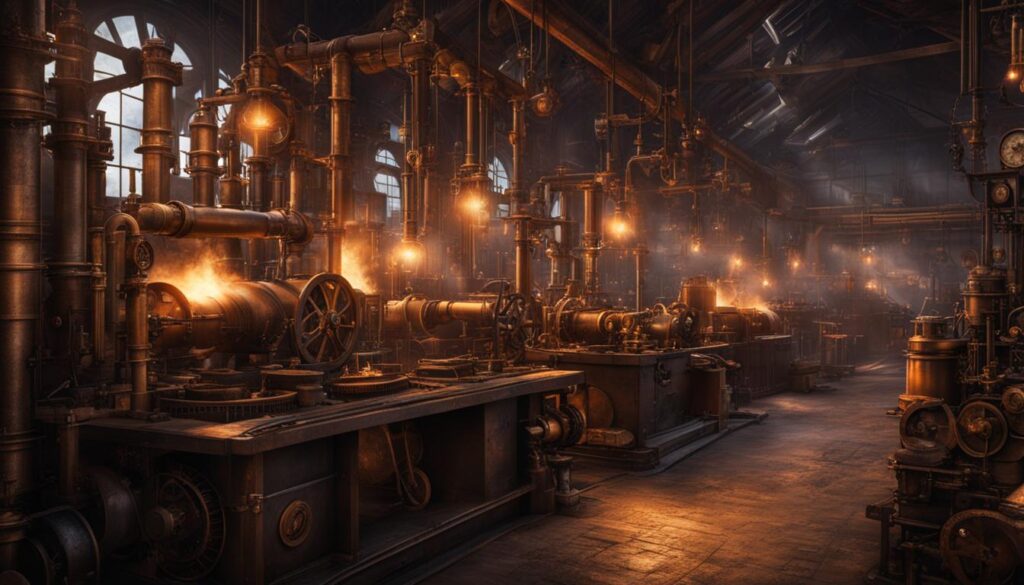
| Country | Notable Steampunk Event |
|---|---|
| United States | Steamposium |
| United Kingdom | Asylum |
| Australia | The Steampunk Empire Symposium |
Table: Steampunk Communities Around the World
Conclusion
Steampunk machinery, with its rich history rooted in the 19th century, continues to captivate creators and enthusiasts alike. Inspired by literature and the Victorian era, steampunk machines have become a countercultural movement that challenges conventional notions of progress and technology.
Designers in the steampunk community have taken historical influences and fused them with futuristic elements, resulting in visually striking and thought-provoking creations. By exploring themes such as colonialism and social inequality, these machines offer a unique perspective on the past and present.
Steampunk’s popularity in popular culture is a testament to its enduring appeal. The genre’s distinct visual aesthetic, merging historical influences with futurism, has made it a recognizable and influential force in films, television shows, and music videos.
Furthermore, steampunk has not only remained confined to the Western world but has spread globally, with enthusiasts around the world embracing the genre. These diverse interpretations bring their own cultural influences and add richness to the steampunk movement.
In conclusion, steampunk machinery’s historical origins, its countercultural undertones, and its ability to bridge the past and the future make it a fascinating and ever-evolving genre. It continues to inspire creators to imagine and create historically inspired steampunk machinery, captivating audiences and leaving a distinct mark on the world of science fiction and alternative history.
FAQ
What is steampunk?
Steampunk is a subgenre of science fiction that incorporates retrofuturistic technology and aesthetics inspired by 19th-century industrial steam-powered machinery.
What time period does steampunk take place in?
Steampunk often takes place in an alternative history of the Victorian era or the American “Wild West,” where steam power remains in use.
What are the main influences on steampunk machinery?
Steampunk draws heavily from 19th-century literature, particularly the works of authors like Jules Verne and H.G. Wells, introducing concepts like airships, steam-powered machines, and alternate histories.
How does the Victorian era influence steampunk machinery?
The Victorian era, with its fashion, architecture, and cultural norms, serves as a major influence on the aesthetics of steampunk machinery, blending historical elements with futuristic technology.
What does steampunk represent as a countercultural movement?
Steampunk challenges dominant narratives of progress and technology, often exploring historical themes such as colonialism, industrialization, and social inequality in its machine creation.
How popular is steampunk in popular culture?
Steampunk has gained popularity in various forms of media, with its distinctive visual aesthetic and historical influences making it a recognizable and influential genre.
Is steampunk a global phenomenon?
Yes, steampunk has become a global movement with enthusiasts and communities spread across the world, adapting historical influences in their steampunk machinery creations.
How has steampunk machinery evolved over time?
Steampunk machinery has evolved beyond a literary genre, inspiring creators and enthusiasts to reimagine history and create historically inspired steampunk machinery.

